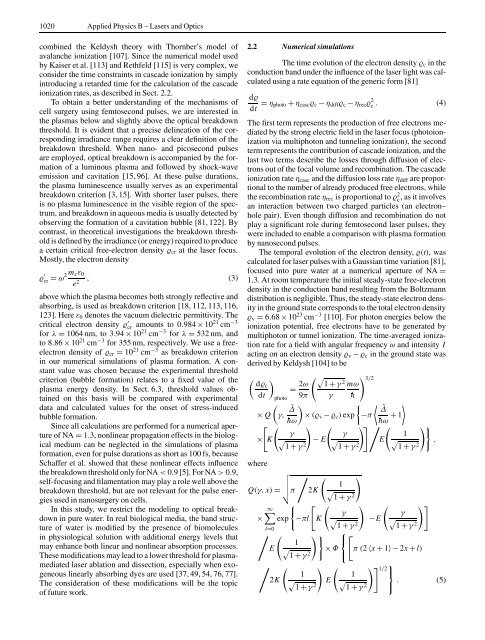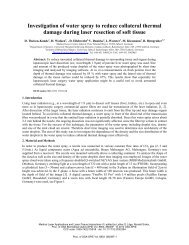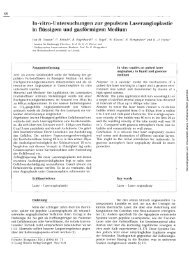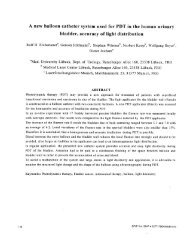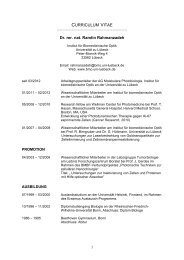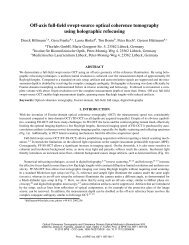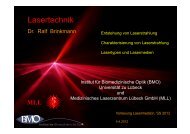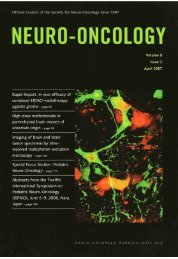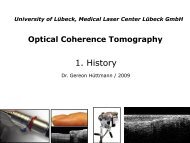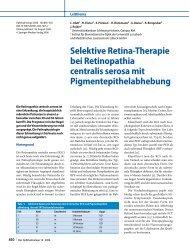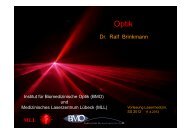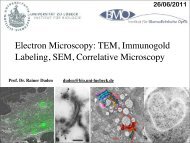Invited p aper Mechanisms of femtosecond laser nanosurgery of ...
Invited p aper Mechanisms of femtosecond laser nanosurgery of ...
Invited p aper Mechanisms of femtosecond laser nanosurgery of ...
You also want an ePaper? Increase the reach of your titles
YUMPU automatically turns print PDFs into web optimized ePapers that Google loves.
1020 Applied Physics B – Lasers and Opticscombined the Keldysh theory with Thornber’s model <strong>of</strong>avalanche ionization [107]. Since the numerical model usedby Kaiser et al. [113] and Rethfeld [115] is very complex, weconsider the time constraints in cascade ionization by simplyintroducing a retarded time for the calculation <strong>of</strong> the cascadeionization rates, as described in Sect. 2.2.To obtain a better understanding <strong>of</strong> the mechanisms <strong>of</strong>cell surgery using <strong>femtosecond</strong> pulses, we are interested inthe plasmas below and slightly above the optical breakdownthreshold. It is evident that a precise delineation <strong>of</strong> the correspondingirradiance range requires a clear definition <strong>of</strong> thebreakdown threshold. When nano- and picosecond pulsesare employed, optical breakdown is accompanied by the formation<strong>of</strong> a luminous plasma and followed by shock-waveemission and cavitation [15, 96]. At these pulse durations,the plasma luminescence usually serves as an experimentalbreakdown criterion [3, 15]. With shorter <strong>laser</strong> pulses, thereis no plasma luminescence in the visible region <strong>of</strong> the spectrum,and breakdown in aqueous media is usually detected byobserving the formation <strong>of</strong> a cavitation bubble [81, 122]. Bycontrast, in theoretical investigations the breakdown thresholdis defined by the irradiance (or energy) required to producea certain critical free-electron density ϱ cr at the <strong>laser</strong> focus.Mostly, the electron densityϱ ′ cr = ω2 m cε 0e 2 , (3)above which the plasma becomes both strongly reflective andabsorbing, is used as breakdown criterion [18, 112, 113, 116,123]. Here ε 0 denotes the vacuum dielectric permittivity. Thecritical electron density ϱ ′ cr amounts to 0.984 × 10 21 cm −3for λ = 1064 nm, to3.94 × 10 21 cm −3 for λ = 532 nm, andto 8.86 × 10 21 cm −3 for 355 nm, respectively. We use a freeelectrondensity <strong>of</strong> ϱ cr = 10 21 cm −3 as breakdown criterionin our numerical simulations <strong>of</strong> plasma formation. A constantvalue was chosen because the experimental thresholdcriterion (bubble formation) relates to a fixed value <strong>of</strong> theplasma energy density. In Sect. 6.3, threshold values obtainedon this basis will be compared with experimentaldata and calculated values for the onset <strong>of</strong> stress-inducedbubble formation.Since all calculations are performed for a numerical <strong>aper</strong>ture<strong>of</strong> NA = 1.3, nonlinear propagation effects in the biologicalmedium can be neglected in the simulations <strong>of</strong> plasmaformation, even for pulse durations as short as 100 fs, becauseSchaffer et al. showed that these nonlinear effects influencethe breakdown threshold only for NA < 0.9 [5]. For NA > 0.9,self-focusing and filamentation may play a role well above thebreakdown threshold, but are not relevant for the pulse energiesused in <strong>nanosurgery</strong> on cells.In this study, we restrict the modeling to optical breakdownin pure water. In real biological media, the band structure<strong>of</strong> water is modified by the presence <strong>of</strong> biomoleculesin physiological solution with additional energy levels thatmay enhance both linear and nonlinear absorption processes.These modifications may lead to a lower threshold for plasmamediated<strong>laser</strong> ablation and dissection, especially when exogeneouslinearly absorbing dyes are used [37, 49, 54, 76, 77].The consideration <strong>of</strong> these modifications will be the topic<strong>of</strong> future work.2.2 Numerical simulationsThe time evolution <strong>of</strong> the electron density ϱ c in theconduction band under the influence <strong>of</strong> the <strong>laser</strong> light was calculatedusing a rate equation <strong>of</strong> the generic form [81]dϱdt = η photo + η casc ϱ c − η diff ϱ c − η rec ϱ 2 c . (4)The first term represents the production <strong>of</strong> free electrons mediatedby the strong electric field in the <strong>laser</strong> focus (photoionizationvia multiphoton and tunneling ionization), the secondterm represents the contribution <strong>of</strong> cascade ionization, and thelast two terms describe the losses through diffusion <strong>of</strong> electronsout <strong>of</strong> the focal volume and recombination. The cascadeionization rate η casc and the diffusion loss rate η diff are proportionalto the number <strong>of</strong> already produced free electrons, whilethe recombination rate η rec is proportional to ϱ 2 c ,asitinvolvesan interaction between two charged particles (an electron–hole pair). Even though diffusion and recombination do notplay a significant role during <strong>femtosecond</strong> <strong>laser</strong> pulses, theywere included to enable a comparison with plasma formationby nanosecond pulses.The temporal evolution <strong>of</strong> the electron density, ϱ(t), wascalculated for <strong>laser</strong> pulses with a Gaussian time variation [81],focused into pure water at a numerical <strong>aper</strong>ture <strong>of</strong> NA =1.3. At room temperature the initial steady-state free-electrondensity in the conduction band resulting from the Boltzmanndistribution is negligible. Thus, the steady-state electron densityin the ground state corresponds to the total electron densityϱ v = 6.68 × 10 23 cm −3 [110]. For photon energies below theionization potential, free electrons have to be generated bymultiphoton or tunnel ionization. The time-averaged ionizationrate for a field with angular frequency ω and intensity Iacting on an electron density ϱ v − ϱ c in the ground state wasderived by Keldysh [104] to be( ) dϱc= 2ωdt photo 9π( )˜∆× Q γ,hω[ ( )γ× K √1 + γ2(√ ) 3/21 + γ2mωγ h{ 〈 〉 ˜∆× (ϱ v − ϱ c ) exp −πhω + 1 ( )] / (γ− E √ E1 + γ21√1 + γ2)}where( )Q(γ, x) = √ 1π/2K √1 + γ 2{ [ ( ) ( )]∞∑γγ× exp −πl K √ −E √l=01 + γ2 1 + γ2/ ( )} ⎧ [1⎨E √ × Φ π (2 〈x + 1〉− 2x +l)1 + γ2 ⎩/ ( ) ( )] ⎫ 1/211 ⎬2K √ E √1 + γ2 1 + γ2 ⎭ . (5),


